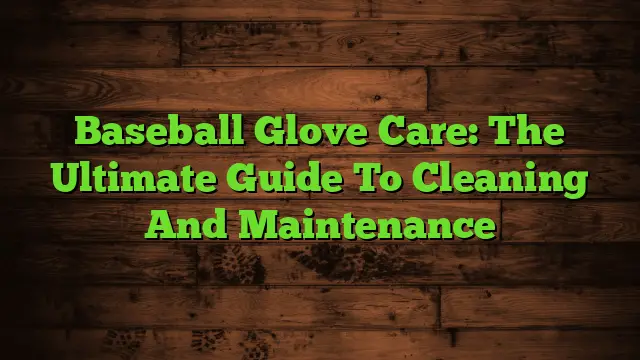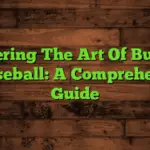A well-maintained baseball glove is an extension of a player’s skill, providing comfort, control, and confidence on the field. Knowing how to clean and maintain a baseball glove properly isn’t just about aesthetics; it’s about extending its lifespan, optimizing its performance, and ensuring you get the most out of your investment. This comprehensive guide will cover everything from basic cleaning techniques to advanced conditioning methods, helping you keep your glove in top shape for years to come. You’ll learn about different materials, common problems, and how to prevent them, ensuring your glove remains your reliable partner on the diamond.
Baseball gloves are primarily made from leather (typically cowhide or steerhide) or synthetic materials. Leather gloves offer superior durability, feel, and break-in potential, but require more meticulous care. Synthetic gloves are more affordable and
easier to maintain, though they may not age as gracefully or offer the same performance as high-quality leather.
Glove Construction and Key Features
Understanding your glove’s construction is crucial for proper maintenance. Key features include the webbing (between the thumb and index finger), the pocket (the area where the ball is caught), and the various stitching patterns. Knowing these components helps you target specific areas during cleaning and conditioning.
The Importance of Glove Care
Why Proper Maintenance Matters
Neglecting your glove can lead to premature wear and tear, reducing its lifespan and performance. Dirt, sweat, and grime can stiffen the leather, making it difficult to close and catch the ball effectively. Regular cleaning and conditioning prevent these issues, ensuring your glove remains supple and responsive.
Basic Cleaning Techniques for Baseball Gloves
Removing Surface Dirt and Debris
Start with a soft-bristled brush to remove loose dirt, grass, and debris. Gently brush the entire glove, paying extra attention to the pocket and webbing. Use a damp cloth (not soaked) to wipe away any remaining dirt. Avoid harsh chemicals or abrasive cleaners.
Treating Stains and Grime
For tougher stains, use a mild soap solution. Mix a small amount of saddle soap or a gentle dish soap with lukewarm water. Apply the solution with a soft sponge or cloth, gently scrubbing the stained areas. Rinse thoroughly with clean water and allow the glove to air dry naturally, away from direct sunlight or heat.
Deep Cleaning Your Baseball Glove
When Deep Cleaning Is Necessary
Deep cleaning should be done periodically, depending on the glove’s usage. If your glove is heavily soiled or smells musty, a deeper clean is warranted. This may involve more thorough cleaning with saddle soap or a specialized glove cleaner.
Step-by-Step Deep Cleaning Process
1. Remove excess dirt with a brush. 2. Apply saddle soap or cleaner according to the instructions. 3. Gently scrub all areas, focusing on heavily soiled parts. 4. Rinse thoroughly with clean water. 5. Stuff the glove with clean, absorbent material (newspaper or glove insert) to maintain its shape during drying.
Conditioning Your Baseball Glove: Keeping It Supple
Why Conditioning Is Crucial
Conditioning replenishes the natural oils in the leather, preventing it from drying out and cracking. Regular conditioning keeps the glove soft, flexible, and responsive.
Choosing the Right Conditioner
Several glove conditioners are available, from commercial products to homemade solutions. Choose a conditioner specifically designed for baseball gloves. Avoid using mink oil or other products not intended for glove leather, as these can damage the material.
Applying Conditioner Properly
Apply conditioner sparingly using a soft cloth or sponge. Rub it in gently, paying attention to all areas of the glove. Let it sit for a few minutes before wiping off any excess.
Drying Your Baseball Glove: The Right Way
Air Drying vs. Forced Drying
Always air dry your glove. Never use a dryer, hairdryer, or direct sunlight, as these can damage the leather. Stuff the glove with a glove form or clean absorbent material to maintain its shape during drying.
Proper Storage and Protection
Protecting Your Glove From the Elements
Store your glove in a cool, dry place away from direct sunlight and extreme temperatures. A glove bag or case can provide extra protection.
Troubleshooting Common Baseball Glove Problems
Stiff Leather: How to Soften It
If your glove feels stiff, you likely need to condition it more often. Apply conditioner as described earlier, and consider using a glove mallet to work it in. Be patient; restoring suppleness can take time.
Cracked Leather: Prevention and Repair
Cracked leather indicates a lack of conditioning. Apply conditioner regularly to prevent cracking. Minor cracks can sometimes be repaired with specialized leather repair kits. Severe cracks may require professional repair or glove replacement.
Loose Stitching: Addressing the Issue
Loose stitching can be reinforced with a strong needle and thread that matches the glove’s stitching. If you are not confident, take it to a professional for repair.
Advanced Glove Maintenance Techniques
Breaking in a New Glove: The Process
Breaking in a new glove involves softening the leather and shaping the pocket to fit your hand. Use a glove mallet, a specialized glove oil, and repetitive exercises to shape the pocket and gradually break in the leather.
Maintaining a Shaped Pocket
Proper shaping of the pocket is essential for catching balls effectively. Use a glove form or a ball to maintain the desired pocket shape when storing your glove.
Comparing Different Glove Cleaning Products
Commercial Cleaners vs. Homemade Solutions
Commercial glove cleaners offer convenience and formulated solutions for specific needs. Homemade solutions, like saddle soap, are more affordable and readily available, however may not be as effective for specific materials.
Reviewing Popular Glove Cleaning and Conditioning Brands
Many brands offer high-quality glove care products. Research and compare popular brands to find the best one for your glove type and preference. Read reviews and consider the cost-effectiveness of each product.
Frequently Asked Questions
What are the signs that my baseball glove needs cleaning?
If your glove has visible dirt, grime, stains, or a musty odor, it needs cleaning. A stiff, inflexible glove also requires attention.
How often should I condition my baseball glove?
This depends on usage and climate. Leather gloves generally need conditioning every few weeks to months, while synthetic gloves may need it less frequently. Monitor the glove’s flexibility and dryness to determine when it’s needed.
Can I use ordinary soap and water to clean my glove?
While mild soap and water can work for light cleaning, stronger solutions or harsh chemicals can damage the leather. Saddle soap or a specialized glove cleaner is recommended for a more thorough clean.
What should I do if my glove gets wet?
Allow the glove to air dry completely away from direct sunlight or heat. Stuff it with absorbent material to maintain its shape during drying. Conditioning after it dries thoroughly is essential.
What’s the best way to store my baseball glove?
Store your glove in a cool, dry place away from direct sunlight and extreme temperatures. Use a glove bag or case for added protection.
How do I prevent mold and mildew in my baseball glove?
Ensure your glove is completely dry after cleaning or getting wet. Store it in a well-ventilated area to avoid moisture buildup. If mold or mildew develops, clean thoroughly with a mild bleach solution and air dry fully.
Final Thoughts
Taking care of your baseball glove isn’t merely about preserving its appearance; it’s an investment in its performance and longevity. By following the detailed steps and advice provided in this guide, you’ll ensure that your glove remains a reliable companion throughout countless games and practices. Remember, regular cleaning, conditioning, and proper storage are key to maximizing your glove’s lifespan and ensuring you consistently achieve peak performance on the field. Don’t let a neglected glove hinder your game – invest the time to maintain it properly. And when in doubt, consult a professional glove repair shop for more intensive care. Happy playing!





